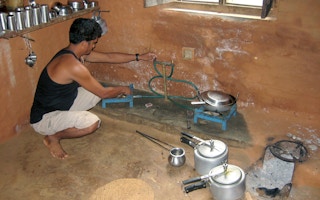Sunita Bote, a 30-year-old housewife from the small village of Kumroj in eastern Nepal, was far from convinced when energy specialists from the capital city, Kathmandu, talked about the benefits of constructing a small biogas plant near her house.
“At first, I shuddered at the thought of connecting my cooking stove with a toilet’s septic tank,” Sunita recalls.
But she was eventually persuaded – and now realises the multiple benefits of the biogas system. The plant not only produces enough energy for cooking for her family of seven, it also gets rid of both human and animal waste.
“It is no longer seems disgusting to me,” Sunita says. “Instead, it has eased my household chores.”
Most of Sunita’s neighbours feel the same way, and Kumroj has now been named by the government as Nepal’s first model biogas village, with more than 80 per cent of households having their own biogas installations.
“
Every biogas plant can save 1.25 trees each year, that means that, due to biogas, nearly 400,000 trees a year throughout the country are saved from being chopped down
Frequent blackouts
Nepal, a landlocked country of just over 26 million people, has big energy problems. Its cities and towns, reliant on imported fossil fuels for energy, suffer frequent electricity blackouts due to ageing infrastructure and shortages of funds.
With its mountain ranges and many rivers, there is great potential for hydropower, but tight budgets mean there has as yet been little investment in these big, capital-intensive projects.
However, the energy outlook is slowly changing. Instead of building big hydropower plants, local groups − helped by NGOs and outside funders − are constructing micro hydro projects all over the country. So far, more than 1,000 such plants have been built. There has also been investment in developing solar power.
Meanwhile, thousands of biogas projects are being put in place in backyards and fields throughout the country.
Fuel needs
According to the Alternative Energy Promotion Centre (AEPC), a government agency responsible for promoting renewable energy, there are now more than 300,000 biogas plants providing for the fuel needs of nearly 6 per cent of Nepal’s households.
“At first, people were wary about getting energy from their toilet septic tanks,” says Professor Govinda Pokharel, vice-chairman of the government’s National Planning Commission and, until recently, a director of AEPC.
“It was human faeces that caused the trouble. People, especially those who were not educated and were living in remote villages, were against the idea of using their faeces for cooking food. In some cases, those who installed biogas plants were even ostracised by their neighbours. But attitudes have changed. When animal dung is mixed with human faeces, greater power is generated.”
Traditionally, wood has been the main source of fuel for cooking and heating. But deforestation – with the resulting landslides and floods – has been a big problem.
Trees saved
The Biogas Sector Programme, a Kathmandu-based organisation that promotes the use of biogas, says every biogas plant can save 1.25 trees each year, That means that, due to biogas, nearly 400,000 trees a year throughout the country are saved from being chopped down.
Biogas not only replaces wood for fuel, it can also help reduce carbon emissions. The UN Framework Convention on Climate Change (UNFCCC) calculates that a standard biogas plant saves greenhouse gas emissions of between three and five tons each year, compared with other energy sources such as wood.
The AEPC says that Nepal, through the use of biogas and by not cutting tree cover, is helping to reduce the country’s overall emissions by more than one million tonnes a year. “It may not be a huge contribution at the global level, but it is not negligible either,” Prof Pokharel says.
There are plans to install at least 26,000 biogas plants around the country each year. “The more we install, the more we save trees,” Prof Pokharel says, “And the saving of each tree is important in combating climate change.”

















